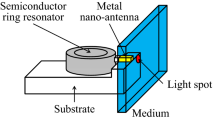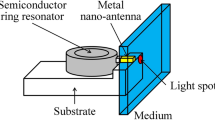Abstract
Heat-assisted magnetic recording (HAMR) is a promising technology with high recording density. The authors’ group has proposed a novel device for HAMR, in which a metal nano-antenna as a near-field transducer is attached to a semiconductor ring resonator as a light source. The ring resonator oscillation should be stable to generate steady near-field light with proper energy density to heat the recording medium. To improve the device performance, the dependence of resonance frequency, electric field intensity distribution, and normalized energy density at the tip of the nano-antenna on ring width and ring size was numerically simulated. When the ring width became wider, the resonance frequency and normalized energy density were more stable and operable, which leads to wide manufacturing tolerance. Although unnecessary solutions with higher radial mode order appeared in this condition, they are easy to control. When the ring size became smaller, the frequency interval between adjacent modes became wider, which leads to the stability of laser oscillation. Moreover, the normalized energy density was increased. As a result, the ring resonator obtains its optimal result with a wide width and an adequately small size.












Similar content being viewed by others
References
Kryder, M.H., Gage, E.C., McDaniel, T.W., Challener, W.A., Rottmayer, R.E., Ju, G., Hsia, Y.-T., Erden, M.F.: Heat assisted magnetic recording. Proc. IEEE 96, 1810 (2008)
Challener, W.A., Peng, C., Itagi, A.V., Karns, D., Peng, W., Peng, Y., Yang, X., Zhu, X., Gokemeijer, N.J., Hsia, Y.-T., Ju, G., Rottmayer, R.E., Seigler, M.A., Gage, E.C.: Heat-assisted magnetic recording by a near-field transducer with efficient optical energy transfer. Nat. Photon. 3, 220 (2009)
Stipe, B.C., Strand, T.C., Poon, C.C., Balamane, H., Boone, T.D., Katine, J.A., Li, J.-L., Rawat, V., Nemoto, H., Hirotsune, A., Hellwig, O., Ruiz, R., Dobisz, E., Kercher, D.S., Robertson, N., Albrecht, T.R., Terris, B.D.: Magnetic recording at 1.5 Pb m-2 using an integrated plasmonic antenna. Nat. Photon. 4, 484 (2010)
Matsumoto, T., Anzai, Y., Shintani, T., Nakamura, K., Nishida, T.: Writing 40 nm marks by using a beaked metallic plate near-field optical probe. Opt. Lett. 31, 259 (2006)
Kuriyama, K., Chabalko, M.J., Kong, Y., Luo, Y., Schlesinger, T.E., Bain, J.A.: Modeling of polarization effects in Au nanodots excited with InAs quantum dot emitters for use as a HAMR heat source. IEEE Trans. Magn. 49, 3560 (2013)
Katayama, R.: Simulation on near-field light generated by Au nano-dot on GaAs substrate for heat assisted magnetic recording heat source. J. Appl. Phys. 115, 17B728 (2014)
Katayama, R.: Simulation on near-field light generated by metal nano-dot on GaAs substrate for heat source of heat-assisted magnetic recording. Opt. Rev. 21, 568 (2014)
Katayama, R., Kasuya, T., Sugiura, S., Yoshizawa, K.: Enhancement of near-field light generated by metal nanodot on semiconductor substrate for heat-assisted magnetic recording heat source. Jpn. J. Appl. Phys. 54, 09MG01 (2015)
Katayama, R., Sugiura, S.: Simulation on near-field light generated by a semiconductor ring resonator with a metal nano-antenna for heat-assisted magnetic recording. Jpn. J. Appl. Phys. 58, SKKB01 (2019)
Kawazoe, T., Kobayashi, K., Ohtsu, M.: Optical nanofountain: a biomimetic device that concentrates optical energy in a nanometric region. Appl. Phys. Lett. 86, 103102 (2005)
Kawazoe, T., Ohtsu, M., Aso, S., Sawado, Y., Hosoda, Y., Yoshizawa, K., Akahane, K., Yamamoto, N., Naruse, M.: Two-dimensional array of room-temperature nanophotonic logic gates using InAs quantum dots in mesa structures. Appl. Phys. B 103, 537 (2011)
Liao, A.S.-H., Wang, S.: Semiconductor injection lasers with a circular resonator. Appl. Phys. Lett. 36, 801 (1980)
Krauss, T., Laybourn, P.J.R., Roberts, J.: CW operation of semiconductor ring lasers. Electron. Lett. 26, 2095 (1990)
Acknowledgements
This work was supported by JSPS KAKENHI Grant Number JP19K04541.
Author information
Authors and Affiliations
Corresponding author
Additional information
Publisher's Note
Springer Nature remains neutral with regard to jurisdictional claims in published maps and institutional affiliations.
Rights and permissions
About this article
Cite this article
Chen, J., Katayama, R. & Sugiura, S. Simulation on parameter optimization of semiconductor ring resonator with nano-antenna for heat-assisted magnetic recording device. Opt Rev 28, 681–692 (2021). https://doi.org/10.1007/s10043-021-00697-x
Received:
Accepted:
Published:
Issue Date:
DOI: https://doi.org/10.1007/s10043-021-00697-x




